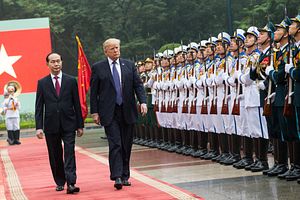This week, a U.S. aircraft carrier will make a port call in Vietnam’s coastal city of Da Nang – just the second visit of its kind since the end of the Vietnam War, following the first in early 2018. Though the move has long been in the works and is just a single engagement, it nonetheless bears noting given its significance for U.S.-Vietnam ties and Washington’s regional approach more generally.
As I have observed before, U.S.-Vietnam relations have come quite far from where they were during the end of the Vietnam War, with the gradual normalization taking off under former President Bill Clinton and continuing on with subsequent Democratic and Republican administrations. That trend culminated in the elevation of ties to a comprehensive partnership in 2015 under President Barack Obama, along with other advances such as the lifting of the U.S. arms embargo on Hanoi. Under the Trump administration, we have seen a mix of notable firsts and new challenges amid talk of the potential elevation of ties to a strategic partnership.
One of the aspects of the U.S.-Vietnam defense relationship is U.S. aircraft carrier visits to the Southeast Asian state. Back in March 2018, a U.S. aircraft carrier, the USS Carl Vinson, made a port call in Vietnam’s coastal city of Da Nang for the first time since the end of the Vietnam War, which constituted both a boost to the defense aspect of the relationship as well as a visible symbol of American regional presence, which is rare for a non-U.S. allied Southeast Asian state to support. Since then, the focus has shifted to what might come next for U.S. aircraft carrier visits, whether it be a follow up to the inaugural voyage or the potential of a more regular schedule of visits in the future.
After months of speculation, this week, we saw reports publicly emerge of a new U.S. aircraft carrier visit to Vietnam this week. The reports first surfaced on BBC Vietnam, subsequently followed by other outlets, including USNI. The latter report cited a confirmation of details by Admiral Phil Davidson, the head of the U.S. Indo-Pacific Command, that the U.S. Navy aircraft carrier USS Theodore Roosevelt will visit Vietnam this week, with a stop scheduled at the coastal city of Da Nang.
Unsurprisingly, not much in the way of details have been disclosed publicly ahead of the visit. But per the South China Morning Post, the visit, which is expected to last a few days, will feature several engagements including a welcome ceremony featuring U.S. Ambassador to Vietnam Daniel Kritenbrink, U.S. Pacific Fleet commander John C. Aquilino, and U.S. Consul General Marie Damour.
The visit will further integrate aircraft carrier visits as one of the relatively newer components of U.S.-Vietnam defense ties, following the first one that occurred in 2018. And, more broadly, it also reinforces Washington’s regional presence and commitment amid China’s South China Sea actions, which have included actions directed against Vietnam in Vanguard Bank since last year.
To be sure, this aircraft carrier visit should not detract from the broader realities in U.S.-Vietnam ties. As I have observed before, the challenges for U.S.-Vietnam ties that have complicated ongoing efforts, including the official elevation of relations to a strategic partnership, lie more outside the defense realm, be it trade tensions or Vietnam’s continued commitment to carefully balancing ties between various powers in line with its various domestic, regional, and international realities. More broadly, some in Hanoi continue to be uncertain about the current status and future trajectory of Washington’s commitment on issues such as China and the South China Sea, as well as how China will react to Vietnam’s moves. Seen from this perspective, the gap between the first and second carrier visits also illustrates the “slowly but surely” progress of defense ties, which is partly the consequence of these broader dynamics.
That should not detract from the importance of the carrier visit. But it should be a reminder that even as we see periodic gains for U.S.-Vietnam relations such as this one, it will be critical to be cognizant of current realities as well as manage future expectations.

































